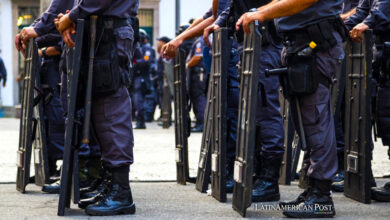Raging Fires Threaten Brazil’s Pantanal Wetlands
Brazil's Pantanal wetlands, a global ecological treasure, face an unprecedented crisis as fires fueled by extreme weather ravage nearly 65% of the region, endangering its rich biodiversity.

11/19/2023.- Aerial photograph of burned vegetation after a large fire on the banks of the MS-184 road in the Brazilian Pantanal, in the city of Corumbá (Brazil). EFE/ Isaac Fontana
Latin American Post Staff
Escucha este artículo
Leer en español: Incendios devastadores amenazan los humedales del Pantanal de Brasil
Pantanal Wetlands Ravaged by Ecological Catastrophe
Brazil's Pantanal wetlands, celebrated earlier this month for the end of the fire season, have been plunged into an ecological catastrophe. Arid and hot weather has ignited a relentless inferno, consuming nearly 1.9 million acres (approximately 3,000 square miles) of this vital tropical ecosystem. Preliminary data from the Federal University of Rio de Janeiro reveals that this devastation accounts for a staggering 65% of the total fire damage witnessed in the region throughout this year.
The magnitude of the crisis has become alarmingly evident, with Brazil's National Institute for Space Research detecting a startling 3,380 fires in the Pantanal during the first 17 days of November. To put this into perspective, last year's period saw a mere 69 fires. The fires pose a severe threat to the Pantanal's extraordinary biodiversity and local communities, homes, and tourism.
The Pantanal, the world's largest tropical wetland, is a critical habitat for thousands of plant and animal species, including 159 mammal species. Among its charismatic residents are the iconic jaguars, making this region a prime destination for wildlife enthusiasts. During the rainy season, the Pantanal's rivers overflow, inundating the land and rendering it accessible only by boat or plane. In contrast, the dry season allows visitors to observe jaguars, macaws, caimans, and capybaras along the riverbanks.
Fires Threaten Jaguar Population and Tourism
However, the fires threaten to disrupt this delicate balance. Much of the Encontro das Aguas (Meeting of the Waters) park, famed for its jaguar population, has transformed from emerald green to a dark, scorched brown. A recent visit by Associated Press journalists captured a poignant image of a jaguar, typically elusive, licking its paws amidst the charred remains of its habitat.
The consequences of the fires extend beyond the loss of habitat and wildlife. Jaguars in the park have become accustomed to human observation and have been a top ecotourism attraction for over 15 years. Preserving these magnificent creatures and their natural environment is paramount to the region's ecological balance and tourism industry.
Firefighters, troops, and volunteers work tirelessly day and night to combat the fires, proving to be an unrelenting challenge. Unfortunately, there is little hope for imminent relief in the form of rainfall. The unusual weather patterns resulting from a heatwave and the El Niño phenomenon have led to higher temperatures and arid conditions, further exacerbating the crisis.
The logistics of firefighting in the Pantanal are daunting. Angelo Rabelo, president of a local environmental group overseeing a protected area of about 1,160 square miles, runs his fire brigade with a limited team of firefighters. Accessing remote fire sites often requires helicopters, making the firefighting effort complex and resource-intensive.
Local Authorities and Communities Join Forces
Local authorities are stepping up their response to the crisis. The state of Mato Grosso do Sul has mobilized its entire fleet of aircraft to support firefighters. The neighboring state of Mato Grosso has also bolstered its firefighting efforts with a significant deployment of personnel and additional financial resources.
Videos shared on social media depict the severity of the situation, with cars driving through corridors of fire along significant access routes to the Pantanal. Thick smoke has hampered visibility, leading to road closures and even a plane crash, injuring four individuals. The limited visibility has also hindered rescue efforts, compounding firefighters' challenges.
The crisis has led to growing frustration among those on the ground who perceive a slow response from authorities. Calls for help from local veterinarians and concerned citizens reportedly went unanswered until it was too late to prevent the fires from spiraling out of control.
Small Reptiles and Amphibians at Risk
While fires are recurring in the Pantanal's natural cycle, this year's events are particularly devastating. Although not as extensive as the 2020 fires, which engulfed around 30% of the Pantanal, the current fires threaten to disrupt the delicate balance of the ecosystem. Small reptiles and amphibians are among the most vulnerable victims, and their plight underscores the critical role they play in maintaining the region's ecological equilibrium.
Also read: Reviving Brazil's Atlantic Forest: A Corridor for Golden Lion Tamarins
The Pantanal's future hangs in the balance as an ecological crisis unfolds. The resilience of this unique wetland and its remarkable biodiversity will be tested as efforts to combat the fires intensify. The fate of this global ecological treasure hinges on swift and effective action to contain the flames and protect the fragile ecosystem that defines the Pantanal




